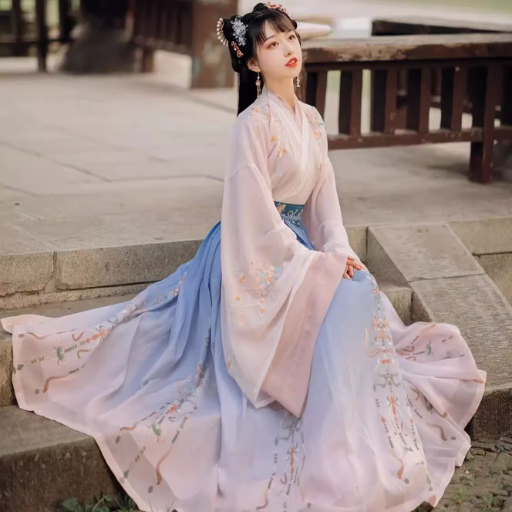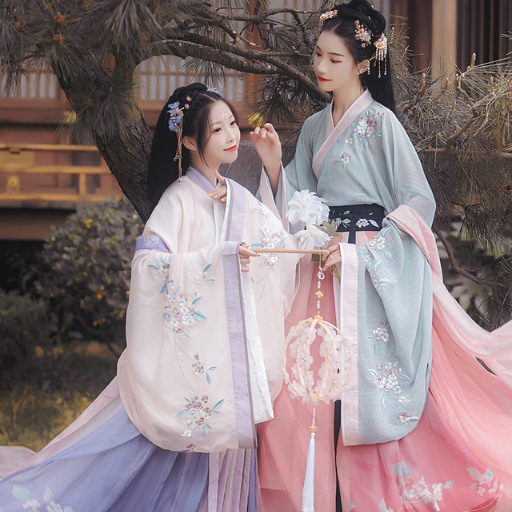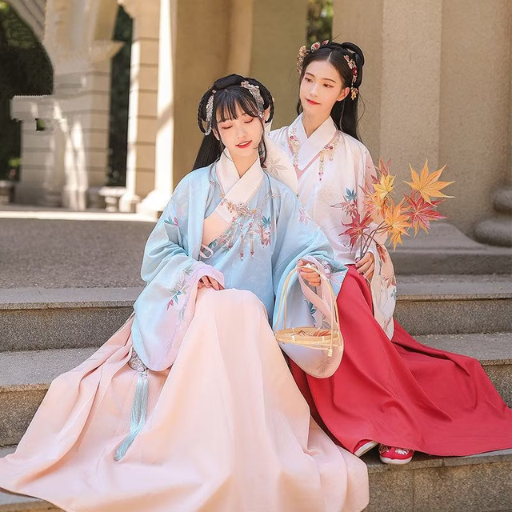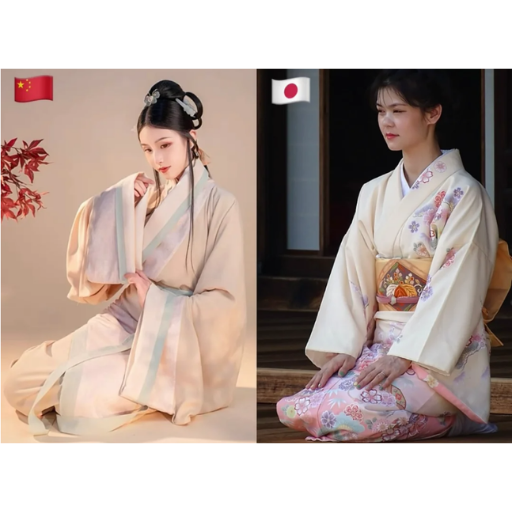Traditional clothes themselves are stories of history and cultures. The Hanfu from China and the Kimono from Japan represent two traditional wardrobes that carry the artistic expressions, philosophy, and everyday life of their respective cultures. While both share social esteem and possess aesthetic similarities, their unique details, symbolism, and historical connotations set them apart.
Introduction to Hanfu and Kimono

China and Japan have been blessed with diverse cultures through their rich historical pasts, with dress representing culture. Hanfu means “clothes of the Han,” dating back over 4,000 years and worn by the Han majority in China. It features flowing layers of robes, often with graceful motifs of prosperity and harmony.
Kimono, originating in Japan over a thousand years ago, is characterized by a T-shaped, straight-lined design with wide sleeves and an obi belt. Both garments stand as iconic symbols of their respective cultures, speaking of craftsmanship, artistic expression, and historical importance.
Hanfu Overview
- Origin: Over 4,000 years ago, during the legendary Yellow Emperor’s time
- Characteristics: Flowing robes with layers, mostly made of silk
- Components: Yi (long tunic), Chang (skirt/lower garment), sash or belt
- Market Value (2022): Over 10 billion yuan (USD 1.4 billion) annually
- Enthusiasts: 7+ million “Hanfu lovers” in China
Kimono Overview
- Origin: Heian period (794-1185) in Japan
- Characteristics: T-shaped, straight-lined front with square sleeves
- Components: Wrapping robe with an obi belt around the waist
- Market Value (2023): Approximately USD 2+ billion globally
- Growth Rate: 5% annual increase in sales
Historical Origins and Evolution
Origins of Hanfu: From the Han Dynasty to Modern Day
Hanfu represents one of the oldest traditional costumes in Chinese history, dating back to the Han Dynasty (206 BCE-220 CE). During this period, the Han Chinese acquired their cultural identity, and this mode of dressing evolved into a significant fashion statement.
Hanfu Revival Statistics
Market Projection: According to iiMedia Research (2021), the Chinese Hanfu Market is projected to reach 10 billion yuan by 2025, reflecting the growing appeal during China’s cultural revitalization.
Hanfu experienced a decline during the Qing Dynasty (1644-1912) when it was replaced by Manchu-imposed clothing. However, recent years have seen a remarkable revival, particularly among younger generations, supported by online communities and social media platforms like TikTok and Weibo.
Origins of Kimono: Historical Development in Japan
The kimono has over 1,000 years of history, evolving during Japan’s Heian Period (794-1185). Initially used as an undergarment beneath more elaborate aristocratic dress, it gradually became the primary garment, with the term “kimono” literally meaning “thing to wear.”
During the Edo Period (1603-1868), the kimono truly entered the heart of Japanese culture, with patterns, fabrics, and styles distinguished by class, season, and occasion. The yuzen dyeing method, developed in the 17th century, allowed artisans to create vibrant, multicolored patterns.
Modern Kimono Industry
Economic Impact (2022): The Japanese kimono industry contributed ¥160 billion to the economy, demonstrating its importance in both local and international markets.
Design Elements and Distinctive Features

| Feature | Hanfu | Kimono |
|---|---|---|
| Collar Design | Cross-collar (Jiao Ling) – left overlaps right | Straight neckline with overlapping panels |
| Sleeve Style | Wide, flowing sleeves | T-shaped with square or rectangular sleeves |
| Fastening Method | Fabric ties and sashes (yao dai) | Stiff obi belt tied at the back |
| Silhouette | Flowing, layered appearance | Straight-lined, structured form |
| Materials | Lighter fabrics: silk, cotton | Heavier silk with precise patterns |
| Pattern Themes | Dragons, phoenixes, clouds (prosperity symbols) | Nature, seasons, cultural motifs |
Distinct Features of Hanfu
- Structure and Layers: Multiple layers, including Yi (upper garment) and Chang (lower garment)
- Cross-Collar Design: Left side overlaps right, symbolizing respect and propriety
- Wide Sleeves: Flowing silhouettes that contrast with fitted Western clothing
- Spectacular Embroidery: Top-notch techniques with dynasty-specific patterns
- Cultural Adaptations: Styles change according to occasion and season
Distinct Features of the Kimono
- T-shaped Construction: Straight robes with geometric precision
- Wide Sleeves: Varying lengths based on marital status and formality
- Obi System: Complex belt wrapping that defines the silhouette
- Symbolic Patterns: Cherry blossoms (fleeting beauty), cranes (longevity), waves (resilience)
- Seasonal Coordination: Specific designs for different times of the year
Cultural Significance and Symbolism

Hanfu in Chinese Culture
Hanfu represents classic Chinese aesthetics with its multi-layered design, conveying harmony and continuity. The garment consists of several main components:
- Yi: Short-sleeve tunic with narrow cuffs
- Chang: Ankle-length pleated skirt
- Hezi: Decorative sash for fastening
Kimono in Japanese Culture
The kimono carries deep cultural meaning through every aspect of its design. Colors, patterns, and wearing methods reflect the wearer’s persona, celebrations, and intentions:
- White: Purity and new beginnings
- Red: Joy and opportunities (bridal kimonos)
- Cherry Blossoms: Transient beauty of life
- Cranes: Longevity and good fortune
- Plum Blossoms: Endurance (early winter blooming)
- Autumn Leaves: Beauty in transformation
Modern Usage Statistics
Kimono Industry (2023): Valued at approximately USD 1.2 billion
Youth Engagement: 60% of present-day wearers choose specific motifs for personal milestones
Seasonal Significance: Traditional seasonal motifs remain important in contemporary designs
Modern Adaptations and Contemporary Use

Contemporary Uses of Hanfu
The Hanfu revival has been remarkable among young Chinese people, who embrace it as a cultural expression and identity. Key developments include:
- Market Growth: Annual sales exceeded 10 billion yuan (USD 1.4 billion) in 2023
- Social Media Impact: Influencers share Hanfu content on platforms, driving popularity
- Rental Business: A Growing industry serving tourists and locals
- Educational Integration: Schools host Hanfu events to promote traditional heritage
- Festival Wear: Popular during Mid-Autumn Festival and other traditional celebrations
Contemporary Uses of the imono
The kimono has successfully adapted to contemporary life through various innovative approaches:
- Industry Revival: Annual sales reaching 250 billion yen
- Tourism Integration: Rental businesses in Kyoto and Tokyo serve international visitors
- Fashion Innovation: Designers blend traditional techniques with modern materials
- Media Presence: Featured in anime, movies, and theater for cultural authenticity
- International Collaboration: Global fashion shows showcase kimono-inspired designs
Casual vs Ceremonial Contexts
| Context | Hanfu | Kimono |
|---|---|---|
| Casual Wear | Modern adaptations for daily wear, photo sessions | Yukata (lightweight cotton) for festivals, summer events |
| Formal/Ceremonial | Traditional festivals, cultural events, and weddings | Furisode (long sleeves), Tomesode (short sleeves) for ceremonies |
| Materials | Silk for formal, cotton for casual adaptations | Elaborate silk for ceremonies, cotton for casual wear |
| Occasions | Cultural pride expression, heritage connection | Weddings, tea ceremonies, coming-of-age events |
Key Differences Summary

Hanfu Characteristics
- 4,000+ year history
- Cross-collar design (left over right)
- Flowing, layered silhouette
- Tied with fabric sashes
- Dragons, phoenixes in embroidery
- Symbol of Chinese cultural revival
Kimono Characteristics
- 1,000+ year history
- T-shaped, straight-lined design
- Structured, geometric form
- Obi belt system
- Nature and seasonal motifs
- Ceremonial and artistic expression
Frequently Asked Questions
What differentiates Hanfu from Kimono?
The difference lies in their cultural origins and design elements. Hanfu features flowing sleeves and a cross-collar design from Chinese tradition, while the Kimono has a T-shaped structure with wrap-around styling from Japanese culture.
How does Hanbok compare to Hanfu and Kimono?
Hanbok (Korean traditional clothing) differs from both with bright colors and simple lines, while Hanfu emphasizes flowing elegance and Kimono focuses on structured grace.
What makes up the primary elements of a Kimono?
Key elements include the T-shaped silhouette, wraparound style, long sleeves, silk construction with seasonal designs, and the important obi belt that binds the entire outfit.
What does Hanfu mean to modern Chinese culture?
Hanfu represents cultural revival and national pride among Chinese youth, frequently worn during festivals and cultural events to celebrate traditional Chinese heritage and historical relevance.
Reference Sources
1. Boston University: China | Fashion – The course provides an in-depth study on the construction and cultural perspective of Hanfu, along with its comparisons to other traditional costumes.
2. Connecticut College: Power and Community in Traditional Chinese Dress-Explores the similarities and differences between Hanfu, Korean Hanbok, and Japanese Kimono, regarding their cultural and historical backgrounds.
3. Wikipedia: Hanfu-A general overview of the topics concerning Hanfu, including its impact on adjacent cultures like Japanese Kimono and Korean Hanbok.







